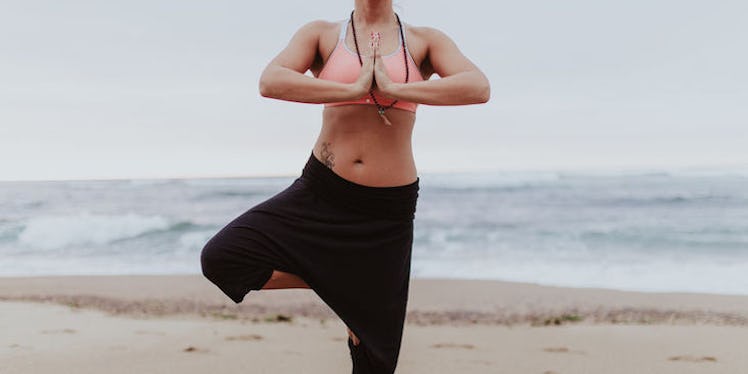
The One Trick You Need To Learn If You Kind Of Suck At Balancing In Your Yoga Practice
You're in your favorite yoga teacher's class, she cues tree pose, and you silently start willing your body to stay centered and stable with ease in the one-legged posture. But alas, you lift one leg and immediately start teetering, only to come not-so-gracefully tumbling down on your butt with an awkward thud. It's hard to learn how to get better at balancing in yoga, and really, every day is different for your body. If you're like me, the challenge doesn't stop you from furrowing your brows and trying the most difficult poses again (and again, and again). But if you're continuing to have trouble with balance no matter how many times you practice, there's a simple, and very straightforward trick that just might help you nail your tree pose once and for all.
The trick is called "drishti," my fellow yogis, and maybe you've even heard your yoga teacher actually utter this word before, but low-key had no idea WTF she meant. To break it down for you, drishti is a Sankrit term that refers to "the method of gazing at a focal point in yoga practice", according to Yoga International.
Outside of the yoga world, you might hear drishti referred to as the "quiet eye" technique. Either way, there's no denying it's an incredibly effective strategy for improving your balance and focus.
Using drishti in your yoga practice means fixing your gaze on a single, non-moving object so you can really hone in on your concentration and send your energy in one direction, which vastly improves your overall balance.
Now, this doesn't guarantee that you're never going to fall out of a balancing pose in yoga class ever again (wouldn't that be sick though?). But, combined with slow and controlled breathing practices, it will help focus your mind in a way that allows a minimal amount of external distractions to penetrate your balance during your time on the mat.
Outside of the yoga studio, the "quiet eye" technique has been studied for its effects on athletic performance. When it comes to competitive sports, the use of a steady eye and fixated gaze can be so powerful that it literally slows the mind during the most crucial moments in a game or competition. A 2016 article published in the journal Current Issues in Sport Science, which reviewed 20 years of research on the "quiet eye" method, found that elite athletes were able to tune out outside distractions and quiet their minds through the use of drishti, which notably improved their overall performance in their respective sports.
And, I mean, how relatable is this to attempting a balancing sequence during your yoga sessions? Especially in a yoga studio setting, think about how many times the person on the mat next to you, or the sight of the instructor briskly walking around the room and adjusting other yogis, has caught your gaze for a hot second and inadvertently completely thrown off your balance. When you think about it, it happens all the time, right?
Even as someone who frequently uses drishti in her own yoga practice, I know that the times I forget to fixate my gaze are the times I feel clumsiest and least focused.
So the next time you're in a yoga class or following along with an online course at home, and the instructor cues tree pose, dancer's pose, eagle pose, or warrior III, try breathing deeply and slowly while activating your drishti by picking a non-moving object in the room to lock your gaze on.
Even if there are distractions surrounding you (which is often the case), such as other yogis in a studio, or one of your fur babies at home, make sure your number-one intention is to not let your gaze wander from that one object you're zoning in on. Allow your eyes and mind to stay soft, not strained. If you fall, be gentle with yourself, and simply try again.